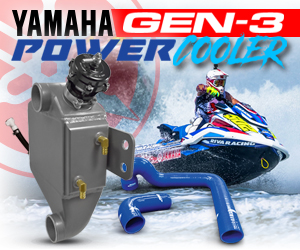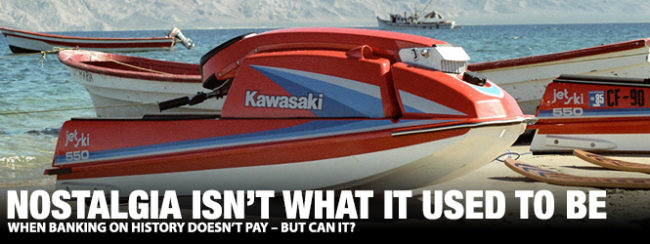
On October 30, 2012, Disney acquired “Star Wars” creator George Lucas’ private studio Lucasfilm for $4.05 billion. Considered one of the biggest transactions in recent entertainment history, Disney wasted no time churning out feature films, cartoons, toys and even clearing 14 acres of the Southern California theme park’s property to create a Star Wars-themed area. Banking heavily on the intellectual property’s (IP) massive impassioned fanbase, Disney projected the potential for tens of billions of dollars in revenue within a decade. That is, until last year.
As politically left-leaning persons hired in key managerial positions felt compelled to imbue films with political messaging, entries like “The Last Jedi” and “Solo: A Star Wars Story” sputtered and fizzled in theaters globally after the fiscal success of “The Force Awakens,” which many considered itself a blatant repackaging of Lucas’ original 1977 Star Wars film, “A New Hope.” Add to that, fan backlash over perceived mistreatment of beloved characters, nonsensical plot points, and a genuine feeling of disdain from filmmakers, and the brand is quickly learning what mistreating the fanbase can do to your bottom line.

No greater has this been felt by Disney than in the toy and merchandise markets. The aforementioned films failed to move a fraction of the product that Disney’s first venture into a galaxy far, far away delivered. So much so, that as toy superstore Toys ‘R Us announced the closure of its nearly 1,700 stores, CFO Michael J. Short attributed failed Star Wars sales as a contributing factor. Today, Disney is scrambling to find ways to rite the ship. Mining the fanbase’s nostalgia has drawn up an empty well it would seem, and Disney’s gargantuan investment is in dire shape according to many projectionists.
Apart from Disney’s milking of the Star Wars IP, nostalgia and “retro” are big business these days. Music, movies, television shows, children’s toys and cartoons are all big dollar properties. Interestingly enough, today’s personal watercraft manufacturers have done very little to capitalize on their respective histories. All three original equipment (OE) manufacturers have accrued long, storied résumés both in and outside of the sport of jet ski racing, which is rife with bold colors, uniquely stylized models and relationships with famed racers that are ripe to be repackaged, labeled and sold as “retro” options and units.
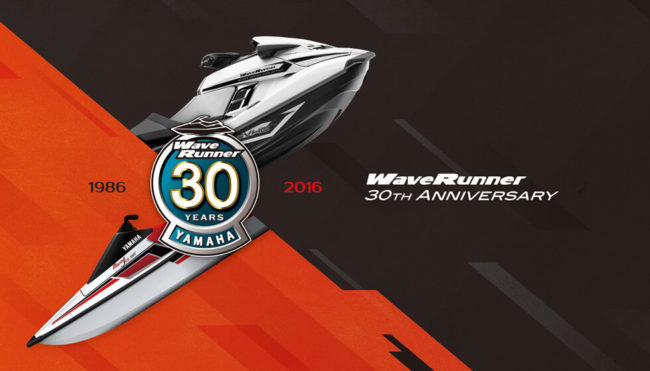
In recent years, OEs Kawasaki, Sea-Doo and Yamaha have hit certain anniversaries for which there has been little to no fanfare. In 2016, Yamaha Motor Corp. USA celebrated 30 years of production of its personal watercraft, the WaveRunner. The year was filled with press releases, media notifications and major updates to its website and social media all documenting the brand’s storied history of the WaveRunner’s development and evolution over the years. In regards to product, Yamaha introduced its redesigned VX platform as well as its new TR-1 3-cylinder marine engine.
Conspicuously absent from the lineup was any markings, emblems or decals noting the anniversary. None indicated anything connoting the particular anniversary. Not even “retro” coloring or decal options. A year after Yamaha revealed the GP1800, Product Manager Scott Watkins pointed out to The Watercraft Journal, “I like that we brought back the old Yamaha racing ‘strobe stripe’ on the blue one.” Noting a subtle nod to Yamaha’s racing heritage on the Team Yamaha Blue ’18 GP. That, and the neon yellow and blue, and Yamaha blue coloring on the ’18 SuperJet appear to be the only nostalgia-inducing cues that Yamaha has incorporated into its craft in recent years.
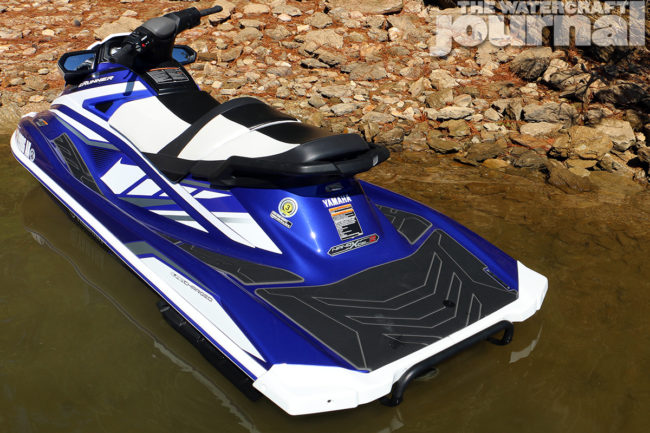
Sea-Doo has all the more reason to celebrate, as 2018 rings in 50 years of personal watercraft (ignoring a large absence between 1970 and 1988). One could argue that half-of-a-century of Sea-Doos on the water would be high ground from which to crow, yet Sea-Doo has been surprisingly low-key about the affair. Like Yamaha, no 2018 model Sea-Doo carries an emblem or decal documenting its 50th anniversary. Prior to the reveal, even we surmised that BRP would be branding its 2018 lineup with “50 Years of Sea-Doo” and slathering half of the lineup in brilliant yellow acrylic paint. In fact, we were dead wrong on both accounts. The ’18 RXT-X 300 is in Neon Yellow and Lava Grey, not the iconic “Sea-Doo Yellow” we were expecting.
In fact, it has only been Kawasaki to truly embrace its longevity. The 2011 SX-R JetSki proudly brandished a gold decal marking 40 years of the JetSki only to have its following year be its final – at least until returning as a 551-pound 4-stroke for the 2017 model year. Interestingly, the new SX-R 1500 is not unlike Disney’s more successful Star Wars film, “The Force Awakens.” Both levied the greatest anticipation seen for a new product in decades. Both whipped online fandom into a furor of rumors, fan theories and hopes. Even spy photos were kept locked down tightly until the final reveal, which was met with polarized reviews from the hardcore to casual enthusiast.
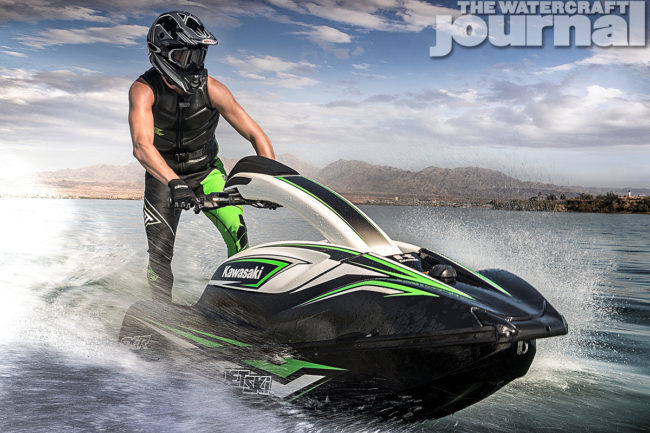
The most vocal were found online of course; hardcore enthusiasts who had never “hung up” their skis were the most critical, compared to those who observed the new ski as a great unit to “get back into” riding standups. Prior to its retail release, Kawasaki conveyed to The Watercraft Journal that the OE hoped to see “around 2,400 units” sold during its first year, as it would appeal to riders “old and new alike.” According to inside-industry sales reports, that number was below half of the original projection. Unchanged for 2018, sales of the SX-R have steadied but definitely not exceeded 2017’s numbers, leaving many to question the health of the standup market altogether.
And that’s the rub that manufacturers are keenly aware of: nostalgia within this industry isn’t enough to translate into actual sales. RIVA Racing has made a solid effort of mining into the sport’s past, printing Yamaha WaveBlaster t-shirts and novelty socks. But is the public interest enough for Yamaha to develop a 4-stroke, 110HP two-seater WaveBlaster? (The originals were marketed as two-seaters too.) The GP1800 remains a strong seller, but do enthusiasts want a yellow-and-black, strobe-striped GP1800R? (And what would the “R” need to entail?) And what of Yamaha’s SuperJet? We’ve noted that 2020 marks 30 years since the SuperJet’s introduction; is a 4-stroke standup worth the investment for Yamaha? Or are new standup sales stagnant? And why not celebrate Yamaha’s racing history with a retro-wrapped RIVA Racing SuperJet?
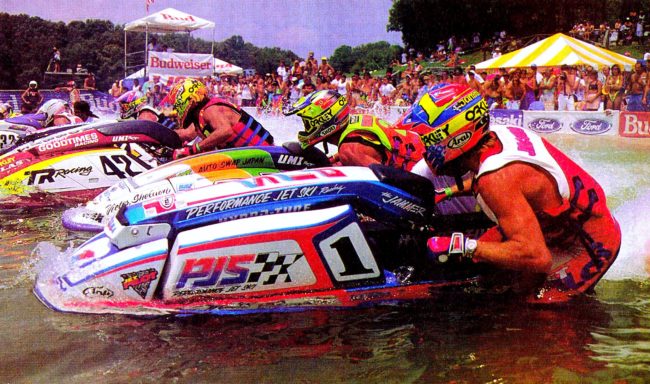
Speaking of which, would special retro-graphic kits celebrating Kawasaki’s most famous racers help buoy current SX-R sales? Would buyers flock to purchase a limited-run Christy Carlson or Jeff Jacobs-Edition SX-R? How about colorful vinyl wraps brandishing vintage PJS and Butch’s logos? The cost for licensing and printing certainly would be minimal when weighed against potential sales. And what about Sea-Doo? Are brilliant, eye-scorching teals, purples, and greens on the comeback? How about a more performance-oriented Spark to egg on the former HX loyalist? How about a Spark with a modular top deck, and we can resurrect the 3D? Handlepole and all? OK, we’re kidding on that last one.
In this instance, nostalgia in and of itself is inert. It is neither good nor bad. When applied properly can render extraordinary results, yet when the intended audience sees it as more of a cash-grab, can backfire spectacularly. It’s our submission that both Sea-Doo and Yamaha failed to seize the opportunity to celebrate their respective longevity, and with it, add a little added value to these specific model year’s units. Equally, we see these companies failing to capitalize on the brand equity they have accrued over so many years. Allow us to celebrate your past with you! Let us relive a little bit of yesterday’s glories in new and exciting ways.











